
Andy Lloyd's Dark Star Blog

Blog 26 (May 2015)
Earth Collision Fragments Found in the Asteroid Belt
The early solar system was likely a chaotic place - something which I suspect few disagree. When examining the merits of Zecharia Sitchin's account of what happened, one of the crucial issues is the initial position of the primordial Earth. He claimed, through his examination of ancient Mesopotamian texts, that the earth Earth was a watery world, much bigger than today's familiar planet, and that it was located early on where the asteroid belt is now - between Mars and Jupiter (1). The ancient Babylonians gave this watery world the name 'Tiamat', a key player in their myth of creation, the Enuma Elish (2). The planet already had a companion at the point when the usurper god/planet Marduk came onto the scene. That companion, named Kingu, was the Moon.
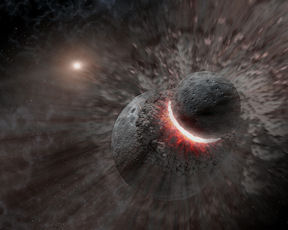
Earth was thumped 4.47 billion years ago
If we are to verify (or discount) Sitchin's account, then it is important to examine evidence about the early Earth's location, and what science can tell us about the catastrophic events which took place during the first billion years of its life. It appears that about 4.5 billion years ago, the early Earth was struck by a Mars-sized body, an event which lead to the formation of our Moon from the resultant debris. Then, 3.9 billion years ago, the entire inner solar system was subjected to a long-term bombardment of massive celestial objects, causing the scarring and cratering we observe across the surfaces of terrestrial worlds like Mars, Mercury and the Moon (the same is no doubt true of Venus, and the Earth, but both of their surfaces have undergone significant reshaping over time, masking the violent effects of those early events).
A new study of meteorites known to have originated from the asteroid belt has provided new evidence that the Moon-formation event left its mark upon the asteroids (3).
"Not too long after the planets began forming, a Mars-sized object slammed into Earth, creating the debris that would coalesce into the moon. But some of the debris escaped all the way out to the asteroid belt. Collisions there left shock-heating signatures that can still be detected billions of years later in meteorites that have fallen to Earth. Planetary scientists have found that a significant number of these altered meteorites have ages clustering at 105 million years after the solar system’s birth—the true age of the moon-forming impact, they say. The result is an independent check on different estimates for the moon’s age, and it suggests that the asteroid belt could be witness to other ancient disruptions in the inner solar system." (4)
Analysis of these asteroidal meteorites has led to an accurate dating of this event to 4.47 billion years ago:
"Nearly 4.5 billion years ago, a colossal impact between Earth and a Mars-size planet triggered the formation of the moon. But the giant collision did more than put a familiar face in our sky: Fragments from the impact not only struck the asteroid belt, but appear to have left telltale scars behind on the asteroids." (5)
My long-standing colleague Lee Covino provided the following succinct commentary:
"For the first time, the mainstream has CONFIRMED that the main asteroid belt contains the remnants of a collision with Earth/Tiamat. Previous probes have confirmed earthly minerals and volatiles on asteroids in the belt, rather than the exotic primordial materials that were expected.
"The article says: "It would have produced a lot of debris that would have been thrown completely out of the Earth-moon system (5)."
But, I say that it was the Earth-moon system that was thrown out of the Mars-Jupiter location of the asteroid belt! The final analysis is probably that there were two major collisions during the formative years of the Earth-moon system, probably caused BY THE SAME DARK STAR BODY AND RETINUE PASSING.
The first created the Tiamat/Earth-Moon system, while the second one reduced Tiamat to the size we see today as Earth.
The second one also scarred the previously-existing Moon (mostly on one side) as we see today.
"Lastly, this second collision, as Sitchin interprets, ALSO CAUSED THE TIAMAT/EARTH-MOON SYSTEM TO MIGRATE TO THE LAGRANGE POINT WE SEE TODAY." (6)
I would add that the model, as presented by the scientists who have undertaken this study, presumes a status quo in the solar system which is highly arguably. They are assuming that at the time of the Moon-formation event (4.47 billion years ago), the asteroid belt was essentially as it is today.
Given that we still don't really truly understand the mechanics of how planets form, we should perhaps be cautious about assuming that the asteroid belt was in place just 100 million years after the birth of the Sun. More likely, this zone was still a mutating part of the swirling primordial disk, within which primordial planets were forming (like the early Earth and whatever struck it). It seems far more likely to me, therefore, that for the asteroids to be intimately connected with a bombarded Earth so early on, a conclusion can be drawn that the asteroids, too, were created from the same event. That could only be true if the Earth began life where the asteroid belt is today.
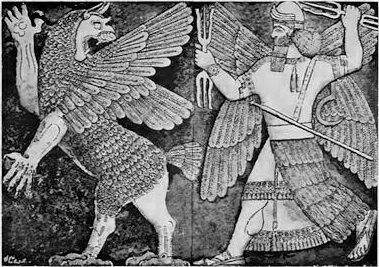
Tiamat and Marduk
This creates some questions for the Sitchinite model. If the Moon (Kingu) was already a moon of the early Earth (Tiamat) when the Dark Star (Nibiru/Marduk) appeared on the scene, then it follows that the asteroid belt was also already in place. So any interaction between the Earth/Moon system and the Dark Star system (Sitchin's 'Celestial Battle', which likely took place during the late, heavy bombardment 3.9 billion years ago), simply led to the migration of the Earth/Moon system (as well as some accompanying bombardment at that time) to where it is today - leaving the asteroid belt behind. For me, this actually makes more sense than the Earth/Moon system migrating at the same time as the asteroid belt formation.
However, in this respect, it doesn't comply so well with Sitchin's account, based upon the ancient Mesopotamian texts (1). Based upon the scientific evidence, the later impact which plunged the Earth/Moon system inwards must have occurred when the asteroid belt was already in existence. Or, alternatively, all of these events occurred at the same time, now reliably confirmed as 4.47 billion years ago.
Written by Andy Lloyd, 22nd May 2015
References:
1) Zecharia Sitchin "The Twelfth Planet" Avon 1976
2) 'Enuma Elish: The Epic of Creation' L.W. King (Translator)
3) B. Bottke et al. "Dating the Moon-forming impact event with Asteroidal Meteorites" Science, 348: 6232, 321-323, 17 April 2015
4) SSERVI "Evidence for Moon-Forming Impact Found Inside Meteorites"
5) Nadia Drake "Asteroids Bear Scars of Moon’s Violent Formation" 16 April 2015, with thanks to Lee
nationalgeographic.com article
6) Correspondence from Lee Covino on the Google Dark Star Planet X Forum, 29 April 2015
A Dark Matter Conspiracy?
Last month, I delved into a discussion about Dark Matter stars which was, to be fair, very much 'out of left field' (1). It was based upon the theoretical work of Dr Vladimir Netchitailo, a physicist specialising in lasers, who had produced a revolutionary discussion paper about the distribution of Dark Matter in the universe, and who said Dark Matter might actually concentrate in particularly dense areas, like galactic cores...and even within individual stars (2). I have to say that even as I was writing it, I felt that on a fairly major level it was unworkable, as most physicists consider Dark Matter to be highly energetic in nature, hence difficult to detect. But as there is as yet little empirical evidence from Dark Matter to inform us of its properties, most of this discussion is merely theoretical, so who knows? Perhaps Dark Matter offers us some new possibilities that aren't simply going to be confined to high-end particle physics.

Shortly after I wrote about this, an article came out describing the distribution of matter and Dark Matter across spiral and elliptical galaxies (3), based upon observed kinematics, particularly the rotational speed of their outlying stars (4). Without dark matter, the speeds should decrease with distance from the galaxy, at different rates for the two galaxy types. The authors used a relatively simple model to provide a 'remarkably good' reproduction of the observed kinematics of these galaxies. They then used Newton's Laws to calculate the mass of these galaxies from the speeds exhibited by their stars. If Dark Matter exists, then it appears to 'conspire' with matter to distribute itself peripherally, in order to produce the required boost to the rotational speeds of the outer stars:
"One of the surprising findings of this study was that spiral galaxies maintain a remarkably constant rotation speed throughout their disks," Dr Cappellari said. "This means stars and dark matter conspire to redistribute themselves to produce this effect, with stars dominating in the inner regions of the galaxies, and a gradual shift in the outer regions to dark matter dominance."
(3)This is at odds with Dr Netchitailo's proposals, which instead seem to concentrate the Dark Matter in the centre of the galaxies (2). Dr Cappellari wonders whether the observed effect of equal rotational speeds of stars across these galaxies might actually be due to Newton's law of gravity becoming progressively less accurate at large distances (3), rather than the existence of Dark Matter. So, either Dark Matter is distributed to the outskirts of galaxies, driving the anomalously high rotational speeds of their outer stars, or else DM doesn't exist at all, and it's all down to the laws of physics needing some adjustment.
Assuming Dark Matter does exist: Let's make another leap here and take this same principle for a galaxy and apply it to a single star system. Might that not mean, then, that Dark Matter congregates in the outer reaches of the star system, driving the star system's rotation (and creating that missing angular momentum in the solar system (5))? That Dark Matter might then take on the form of any number of smaller, essentially invisible sub-stellar bodies - like, for instance, a Dark Star at the periphery of the solar system. Is this even necessary anyway? After all, a sub-brown dwarf made of perfectly ordinary matter would suffice just the same.
Written by Andy Lloyd, 25th May 2015
References:
1) Andy Lloyd "A Star Made of Dark Matter" 17 April 2015
2) Vladimir Netchitailo "4-D World - Universe Model. Overview" 5 March 2015
3) Lea Kivivali "The Dark Matter 'conspiracy'" 30 April 2015, with thanks to Lee
4) M. Cappellari et al. "Small Scatter and Nearly Isothermal Mass Profiles to Four Half-light Radii from Two-dimensional Stellar Dynamics of Early-type Galaxies", The Astrophysical Journal Letters, 804: L21, 2015
5) Andy Lloyd "Missing Angular Momentum and the Dark Star" 23 February 2015
The Lights of Ceres
Bright 'lights' on the surface of the major asteroid/dwarf planet Ceres. It's the stuff of science fiction, but NASA's Dawn spacecraft has imaged rather spectacular bright spots on one of the craters on its Northern Hemisphere (1). Everyone's puzzled by them, and looking forward to closer images as Dawn draws nearer.
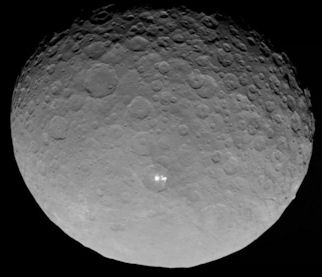
Image Credit: NASA/JPL - Caltech
The most recent 'official' word has it that the lights are due to light bouncing off highly reflective material on the surface of the dwarf planet:
""Dawn scientists can now conclude that the intense brightness of these spots is due to the reflection of sunlight by highly reflective material on the surface, possibly ice," Christopher Russell, principal investigator for the Dawn mission from the University of California, Los Angeles, said recently." (2)
But there is still a considerable element of doubt about the nature of that material, even among mission specialists:
"In photos released from its first science orbit, [Ceres] shows its cratered face and, in a few of those craters, the mysterious white spots NASA scientists have been puzzling over for months. A photo taken May 4 by NASA’s Dawn spacecraft shows the largest to be a number of differentiated white spots that some interpret to be water ice.
"Mark Sykes doesn’t think so. Sykes, director and CEO of Tucson-based Planetary Science Institute, says if Ceres held that much ice it would have registered a much stronger signal with NASA’s Herschel Space Telescope. The spots might be minerals left over from evaporated ice, said Sykes, who is a co-investigator on Dawn’s science team.
"He said science team members had plenty of conjectures about Ceres when they met in Santa Monica, California, a couple of weeks ago. He’s not willing to draw any conclusions from images that represent 1.2 kilometers per pixel." (3)
Given the immensity of the areas involved, it
does seem likely that we're looking at some kind of unexpected zone of ice, glinting brightly in the sun. Perhaps Ceres is like the Galilean moons and under its surface lies an asteroid-wide frozen ocean. In which case, Ceres would be like an icy billiard ball topped with heavily cratered rocky terrain, and covered in igneous rock and dirt (from previous volcanic outflows?). If so, then the bright lights might be relatively fresh impact areas that have exposed the pristine ice below, which is then highly reflective in sunlight.Perhaps Ceres was
itself once a Galilean moon of Jupiter, stripped away from its siblings early on during the solar system's tumultuous history?In some of these images, an object has been spotted moving across the field of view (4). The moving object adds an extra dimension, further heightening speculation that this whole zone of interest may be artificial in origin. If confirmed, the moving object could well be an undiscovered moon of Ceres. Or, if my hypothesis about a relatively recent impact is correct, then perhaps it's some of the impact debris now orbiting around Ceres.
NASA appears to be maintaining an open mind on the issue of the bright spots, and has even opened up a website poll to gauge public opinion about the various proposed solutions to the mystery (5).
Written by Andy Lloyd, 25th May 2015
References:
1) NASA/JPL "PIA19547: Ceres RC3 Animation"
photojournal.jpl.nasa.gov catalog
2) NASA/JPL "Ceres Bright Spots Seen Closer Than Ever" 20 May 2015
3) Tom Beal "NASA craft could clear up Ceres, Pluto riddles" 17 May 2015 thanks to Wayne
4) Paul Seaburn "UFO Spotted Circling Mysterious Lights on Ceres" 17 May 2015 with thanks to Lee
mysteriousuniverse.org article
5) NASA/JPL "What's the spot on Ceres?" (poll webpage no longer available )
A New Calculation of the Dark Star's Mass
I've been shown a new paper, being prepared for
publication, which demonstrates a missing mass in the solar system (1).
The physics behind this is quite complex, although the author in
question has done an excellent job of making it as accessible as
possible. He has shown that the solar system's angular momentum is
inconsistent with established physics. Any argument that this is
due to a lack of equilibrium in the overall energy of the system is not
borne out by observed facts, leading to a disparity between mass, energy
and angular momentum.
The author has then calculated the mass for the
missing object which is needed to bring all of these factors back into
line, as a function of distance from the Sun. I'm not going to
steal his thunder by revealing that information at this stage; and will
report on it in a future blog once his paper is published.
Needless to say, this groundbreaking new work will be good news for
Planet X hunters hoping to find a substantial celestial body out
there... Andy Lloyd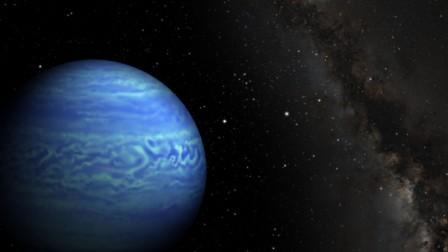
References:
1) Correspondence received from R.F., 16 May 2015
A 'Hot Saturn' Raises New
Questions An international team of researchers have
observed the movement of a sizeable gas-giant world, orbiting a young
red dwarf star (designated HATS-6) some 500 light years away. What
makes this discovery special is the fact that this planet seems way too
big for its small parent star. It also lies extremely close to the
parent M-dwarf star - a tenth the distance of Mercury to the Sun (1,2).
It whizzes around the M-dwarf in just 3.3 days, making little old
Mercury appear positively tortoise-like in comparison. "We have found a small star,
with a giant planet the size of Jupiter, orbiting very closely," said
researcher George Zhou from the Research School of Astrophysics and
Astronomy at The Australian National University. "It must have
formed further out and migrated in, but our theories can't explain how
this happened." (3) The proposed mechanism for such a drastic inward
migration relies upon physical interactions with the proto-planetary
disk: "Scientists do not think hot
Jupiters such as HATS-6b form where they now orbit; at such close range,
the radiation and winds from their host stars would blow away most
nearby matter, leaving too little to form such large planets.
Instead, researchers think giant planets are born far away from their
stars and then migrate inward because of physical interactions with the
ring of gas and dust that initially surrounds young stars, or as a
result of gravitational interactions with nearby planets."
(4) But, in this case, how could the small
proto-planetary disk of a M Dwarf really be expected to kick such a
large gas giant inwards? This does seem a very extreme case, if
this standard mechanism is to be applied here. Another aspect of
this puzzling planet is its density. It is less
of a 'hot Jupiter' and more of a 'hot Saturn': "The planet has a similar
mass to Saturn, but its radius is similar to Jupiter, so it's quite a
puffed up planet". (3) Density-wise, this planet is incredibly light.
The discovery calls into question standard models of
planet formation, none of which is able to predict such a massive
gaseous world in such close proximity to a young red dwarf star.
There is some speculation that the red dwarf and this
super-light gas giant formed together, from the same central part of the
revolving proto-stellar nebula, and then separated at birth (5).
There is a precedent for this kind of separation, in the form of
the rather bizarre Wolf-Rayet stars.
These begin life big -
initially containing at least 20 times more mass than the sun. But
their hydrogen-dominated outer layers soon puff up and are lost,
exposing the objects' helium-burning cores to space. Arguments
about the mechanism remain unresolved (it's either due to the star's own
strong stellar wind driving off the outer hydrogen layers, or their
being dragged off by a binary companion) (6). Certainly, this is a very different beast to our tiny
M Dwarf HATS-6, but if the binary star ("cosmic cannibalism") mechanism
is the correct one, then this may lead to an understanding of how 'hot
Jupiters' might form in a more general sense. If outer,
hydrogen-rich layers of stars are being drawn off by binary companions,
and then if that process is interrupted for some reason (the loss to
interstellar space of the binary companion, for instance), a 'hot
Jupiter' might result. Andy Lloyd, 25th May 2015 References: 1) 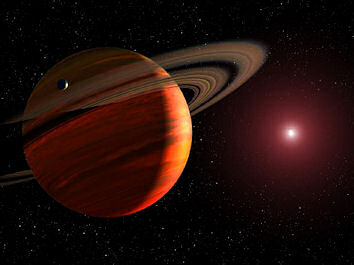
2) "Planet HATS-6 b"
3) Australian National University "New exoplanet too big for its star challenges ideas about how planets form", 1 May 2015, with thanks to Lee
4) Charles Choi "Exoplanet Puzzle: How Is This Giant Alien Planet Too Big for Its Star?" 20 May 2015
5) Sci-News "HATS-6b: Astronomers Discover Strange Saturn-like Exoplanet" 1 May 2015, (and following discussion):
6) Mike Wall "Strange 'Nasty' Star May Be Spawned by Cosmic Cannibalism" 22 May 2015
Water's Earliest Beginnings
The Universe's cosmic waters emerged far earlier than has been thought,
new research has shown. Even though the abundance of oxygen in the
Universe was still very low by today's standards, water could still form
in the early molecular clouds at temperatures akin to a warm summer's
day (1,2). Water appeared just a billion years into the history of
the universe - a finding which has profound implications for the
potential early emergence of life in the universe. ""We found that
it is possible to build up significant quantities of water in the gas
phase without much enrichment in heavy elements," said [Shmuel]
Bialy. "In this current work, we
calculated how much water could exist in the gas phase within molecular
clouds that would form later generations of stars and planets. In
future research we intend to address questions such as how much water
could have existed as interstellar ice, as in our own galaxy, and what
fraction of all the water might actually be incorporated into
newly-forming planetary systems."" (1) This also implies a ready abundance of water in
later, 'recycled' star forming regions throughout the life-time of the
galaxy. Life could have emerged early on, through the warm,
aqueous conditions available in the early universe, and then spread out
- through Panspermia - steadily over billions of years. Our own
solar system might well have begun life with abundant water incorporated
within its condensing nebula, with the accompanying seeds of life ready
to go... As we began this blog, the prospects for a
monster-sized watery mother world containing everything needed for life
(i.e. "Tiamat") seems very reasonable indeed. Andy Lloyd, 25th May 2015 References: 1)
2) Shmuel Bialy et al "Water Formation During the Epoch of First Metal Enrichment", The Astrophysical Journal Letters, 804: L29, 2015
'Memory Metal' Engineered 68 Years After Roswell
One of the holy grails of engineering is to create a memory allow that can repeatedly conform back into its initial shape despite multiple episodes of stress and bending out of shape. This has proven tricky, with previous hopeful new alloys failing to live up to expectations. Now, university researchers from Maryland, USA and Kiel, Germany, have created a new 'memory alloy' that still retains its memory despite having been bent more than 10 million times (1). This opens doors for several major advances in engineering:
"The new material - made from nickel, titanium and copper - shatters previous records and is so resilient it could be useful in artificial heart valves, aircraft components or a new generation of solid-state refrigerators. The key to its remarkable properties is the way it is crystallised. The nickel, titanium and copper atoms are arranged in such a way that they can switch between two different configurations - again and again and again. This "phase transition" is what causes the alloy to snap back into shape after it is bent. It can be triggered by heat, or, in a different form of the alloy, it can happen as soon as the tension is released...
"Prof Huber [of the University of Oxford] said the properties might prove useful in the wing flaps or "control surfaces" of aircraft, or the unfolding solar panels of a spacecraft, as well as artificial heart valves." (2)
As long ago as 2001, my research colleagues and I were reporting on on-going efforts by DARPA to create 'morphing metals', mostly in the form of their Compact Hybrid Actuation Program, or CHAP (3). These tiny actuators are mechanical devices which perform an action under the influence of, say, a magnetic field, or electrical stimulation. They could be used to morph the shape of an aeroform in flight, for instance.

Even back in 2001, there were hopes that one day scientists would be able to create (re-create?) "shape memory alloys" which could autonomously "self-actuate". This new memory metal alloy seems to be a great step forward in this long-standing metallurgical research effort.
We have often discussed possible links between these research developments and rumours of back-engineering of recovered 'memory metals' from the desert floor of New Mexico in 1947, as described here by Colonel Philip Corso:
“There was a dull, greyish-silvery foil-like swatch of cloth among these artifacts that you could not fold, bend, tear, or wad up but that bounded right back into its original shape without any creases. It was a metallic fibre with physical characteristics that would later be called “supertenacity,” but when I tried to cut it with scissors, the arms just slid right off without even making a nick in the fibres. If you tried to stretch it, it bounced back, but I noticed that all the threads seemed to be going in one direction. When I tried to stretch it width-wise instead of length-wise, it looked like the fibres had re-orientated themselves to the direction I was pulling in. This couldn’t be cloth, but it obviously wasn’t metal. It was a combination, to my unscientific eye, of a cloth woven with metal strands that had the drape and malleability of a fabric and the strength and resistance of a metal. I was on top of some of the most secret weapons projects at the Pentagon, and we had nothing like this, even under the wish-list category.” (4)
This description, although interesting, is not exactly what over two dozen eye-witnesses of the famous 'memory metal' recovered near Roswell in 1947 described (5). The memory metal was just one of nine materials described from the site by witnesses, as related by researchers Thomas Carey and Donald Schmitt:
"An unknown quantity of very small to hand-sized pieces of a very thin and very light “metal” that displayed both solid and “fluid” qualities. The colour of dull aluminium, a piece of it could be wadded up like a ball in one’s hand [without any sensation of weight] and, when placed on a flat surface, it unfurled [“flowed like water”] to its original flat, seamless shape without a mark on it. Also extremely tough, it could not be cut, scratched or burned." (6)
This sounds more like the Nickel/Titanium/Copper alloy now confirmed as a true, highly resilient memory metal. Sixty Eight years on, has humanity finally mastered the material from the Roswell saucer?
Andy Lloyd,
30th May 2015
References:
1)
C. Chluba, et al. "Ultralow-fatigue shape memory alloy films", Science, 348: 6238) 1004-1007, 29 May 20152) Jonathan Webb "Memory alloy bounces back into shape 10 million times" 29th May 2015
3) Andy Lloyd, Dave Cosnette & Martin Cosnette "US Military are using smart metals similar to those found at the Roswell Crash In 1947" 9 Dec 2001, 19 Feb 2009
4) Col. Philip Corso "The Day After Roswell" p49 Pocket Books 1997
5) Thomas Carey & Donald Schmitt "Witness to Roswell" p42, New Page Books, 2009
6) UFO Magazine (UK), Sept/Oct 2000, p62

You can keep informed of updates by following me on Twitter:
![]()
Or like my Facebook Page: https://www.facebook.com/darkstarandylloyd